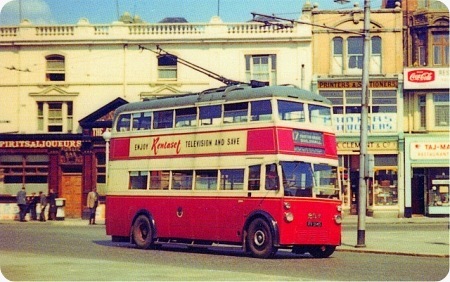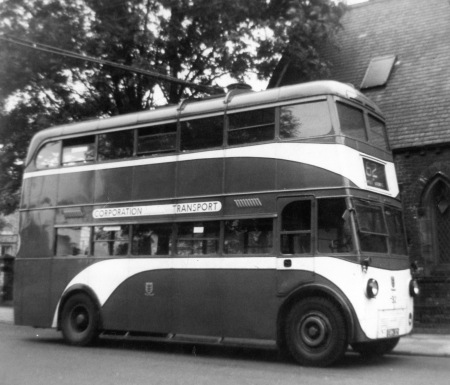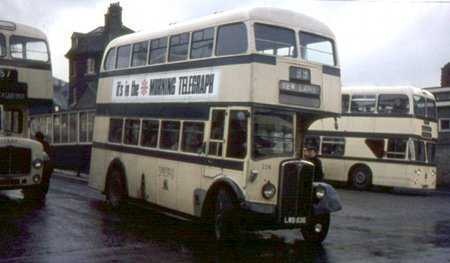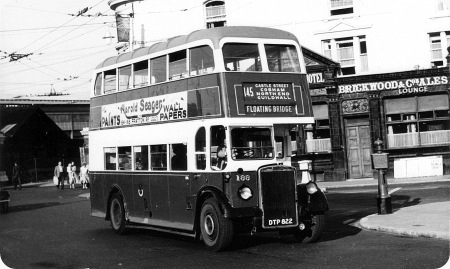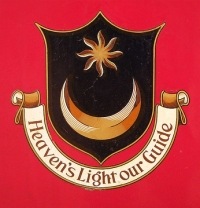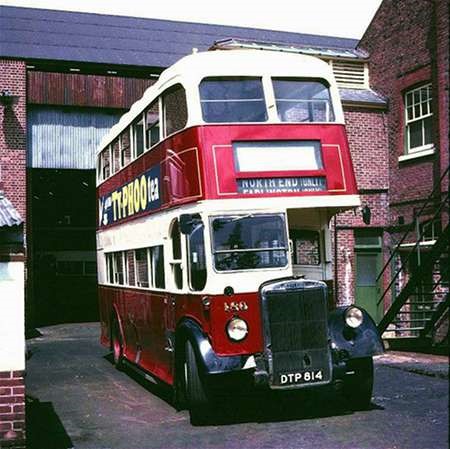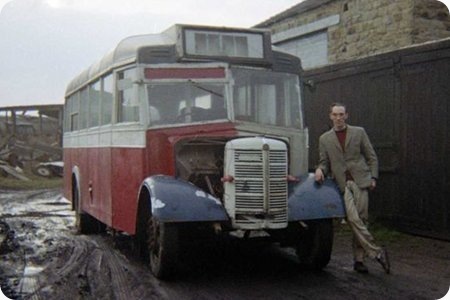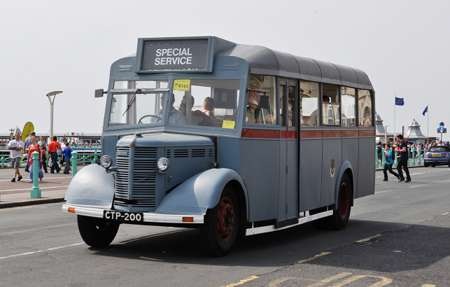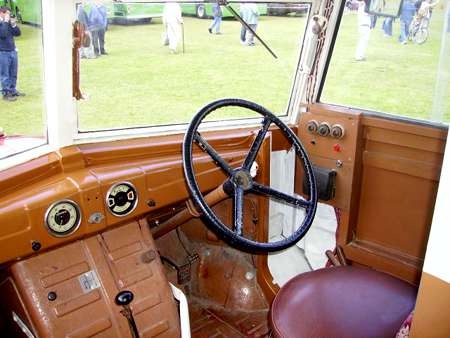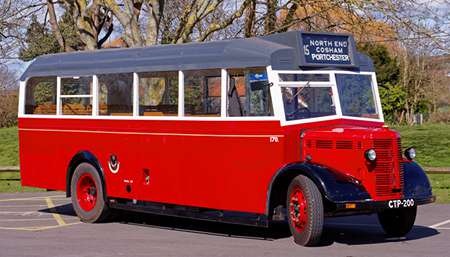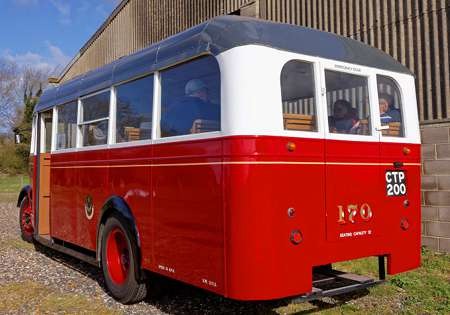Portsmouth Corporation – AEC 661/EE – RV 9148 – 294
Portsmouth Corporation
1937
AEC 661T/English Electric
Craven H26/26R
Portsmouth Corporation had 115 trolleybuses in its fleet.
The first 15 (1934) were a motley collection of chassis/electrical equipment and bodies, four and six wheelers, bought for evaluation.
The next nine (1935/36) were, to me, the most handsome of them all, were AEC/EE ones with English Electric bodies. Unable to move under their own power, they lived a shadowy life, latterly neglected and shabby. See here for a ‘smart’ photo of one.
The last 15 (301-315), BUT9611T, with Burlingham bodies, were the last delivered, in 1951, for a route extension.
294, from the third order, in the range (225-300), was the largest group delivered, in 1936/37. Amazingly, with not a Craven body appearing previously, these wore those bodies! They bore the brunt of the services and proved to be sound vehicles all round, although the ash bodies needed rebuilding during their 26/27 year lives.
In this rare colour photograph, 294 (like the Leyland PD1A/Weymann bus I recently posted), is also crossing Guildhall Square on tennis racquet-shaped route 17/18 from Eastney to the Dockyard, 17 anti-clockwise and 18 clockwise. The destination would be changed at Dockyard and Eastney. This photo was taken on an early Summer’s evening in 1963, on the cusp of the system’s demise on 27th July 1963. 294 lasted to the end.
Two trolleybuses have survived, but neither of them represents this range; a loss really, for I’m not aware of Craven using this body design for any other vehicles.
Photograph and Copy contributed by Chris Hebbron
———
Thank you Chris for another lovely Portsmouth photo of a very deserving type of trolleybus. The AEC 661T/Craven trolleybuses were the workhorses of the fleet and I have very fond memories of a visit to ride on them in 1963. I have always remembered the internal finish of the Portsmouth Cravens to be an excellent show of Civic pride.
I do believe similar Craven bodies were built for Kingston -upon-Hull on Crossley TDD4 trolleybus chassis nos. 27 to 46 in 1938.
Richard Fieldhouse
———
08/01/12 – 16:22
The Cravens (full title Cravens Railway Carriage and Wagon Company Ltd) bore similarities to the twenty Cravens bodied Crossleys delivered to Hull in 1938. the majority entered service on 2 September 1938, eight lasting until 3 February 1962. There was an option for a further 54 bodies which was not taken up.
Malcolm Wells
———
08/01/12 – 18:25
Thanks, Richard/Malcolm for the comments/photos about the similarly-bodied trolleybuses to the above example. I can see a likeness.
I always liked the inside décor and furnishings of Portsmouth’s pre-war buses. Mahogany bulkheads with bevelled-edge mirrors, leather-edged, comfortable seats with a flowery pattern more akin to art nouveau than art deco. Covered lights and lined-out ceilings completed the picture.
If you use the link I mentioned above, go to David Beilby’s website and scroll a few pictures back from the one on display, there are some examples of what I mean.
Chris Hebbron
———
11/01/12 – 06:44
When clicking on the link to one of the batch of nine English Electric bodied AECs of 1935, a picture of No 24 is displayed. A previous picture on that site shows No 21 of the same batch. The contributor there notes that the electrical support structure on the roof is enclosed on No 24, but is open framed on pictures of the others in the batch. I suspect that the reason for this is that No 24 was exhibited at the 1935 Commercial Motor Show, and was built thus for that purpose. Although presumably delivered to Portsmouth after the Show, it did not enter service until April 1936. It became the last of the batch to survive, being withdrawn in 1958. As far as the Cravens-bodied stalwarts are concerned, they were what a Portsmouth trolleybus was expected to look like – just as an RM or RT represents London! No 237 reportedly survived in a Portsmouth scrapyard near the erstwhile airport for several years – possibly even into this century? But I have not heard whether it still survives, and if so whether it is accessible. No 313, a Burlingham bodied BUT of 1951 (Portsmouth’s last to run in service on 27 July 1963) is in fine fettle at Carlton Colville, I believe. No 201 (Portsmouth’s first numerically) has had a more chequered preservation career, first at Beaulieu Motor Museum, then back to Portsmouth, and ended up at the Milestones Museum in Basingstoke. About two years ago, it looked rather sorry for itself, and at my last visit early last year, it was not on display. I would hope that it is out of display for some smartening up work at the very least.
Michael Hampton
———
11/01/12 – 10:33
Thx, Michael, for the interesting titbit about 24 being in the 1935 Comm. Motor Show. You mention one Cravens survivor hanging on in Pompey somewhere and I believe another one did for a few years as a public convenience in Bristol – I think I saw a photo of it once, painted white. I saw 313 only in October, but it was in the ‘garage’ and I was unable to see anything other than an impeccable rear: it wasn’t running that day. Were these distinctive Burlingham bodies replicated on other contemporary (trolley)buses? I can’t recall any others, off-hand. And you’re so right about the Craven’s ones. The comprehensive and intensive system Pompey had, meant that a trolleybus was barely ever out of sight and the 75 Cravens ones seemed to total more like 200, always popping up. Wherever you went, there they were! Fratton Bridge was a complex junction for the overhead and I used to happily spend 20 mins watching the poles picking their way across the wires and frogs. The last (evening) journeys were still by trolleybus, even when the system officially closed down, and that was my last ride on a Cravens. Happy days!
Chris Hebbron
———
11/01/12 – 13:19
I always thought that Cravens bodies were full of character, regardless of operator or application. Having waxed lyrical in many discussions about how I loved the Cravens RTs in London I’ve usually found that I couldn’t convince the opposition – sad really, because I think that they are missing something very attractive in the five bay construction within the RT classic outline – a magical combination in my view.
Chris Youhill
———
11/01/12 – 17:08
I have a prejudice in favour of Cravens because they were from my home town (Sheffield) and provided many STD buses from the mid thirties until 1950. [At this point they left bus building until they bought East Lancs in 1964 – and also formed Neepsend Coachworks.]
The last Cravens (1950 Regent IIIs)were among my favourites – and I thought amongst the most attractive of the immediate post war designs. They were almost identical to the RTs – but minus the "Londonisms".
David Oldfield
———
12/01/12 – 06:01
I always liked the Cravens’ RT’s, too. They were nicer to look at, in all respects, save for the hunched back and, if I recall correctly, the emergency windows and lower rear window did not match up, either. Nevertheless, they made a good stab at making a pseudo-RT body from a standard design shell. Surprisingly, there are only two postings of Cravens’ bodied vehicles on this website, which should be rectified! Perhaps David could post a photo of the 1950 AEC Regent III’s he mentions. It would make an interesting exercise to compare them with the Londonised RT’s.
Chris Hebbron
———
12/01/12 – 06:07
The latest comment by David Oldfield on the Portsmouth Cravens trolleybus has reminded me of this slide, taken by a friend of mine when we visited Sheffield in December 1966. I guess this is the batch he is mentioning
Bob Gell
———
12/01/12 – 06:05
Re above posting from Chris H, Here is a picture of the rather unfortunate Portsmouth ‘bus that ended it’s days in a rather unusual service role. It was used as such for many years, maybe around fifteen or even more! It was in use during 1961 and as far as I am aware it disappeared about 1980 //farm8.staticflickr.com/
No 313 has survived in fine condition and can be seen in running order here. //www.youtube.com/
Richard Leaman
———
12/01/12 – 10:38
Bob’s slide is most pleasing, and shows well the very attractive upper saloon front bay and roof dome which I’ve always found to be a particularly classic outline.
Richard’s comparison of the two latter careers of the Portsmouth trolleybus are heart warming, and the visitors to Carlton Colville are obviously flushed with enthusiasm at the relaunch.
Chris Youhill
———
12/01/12 – 10:39
Thx, Bob, for the Sheffield bus photo, from which I can see something of the ‘RT’. Did these bodies have the hunched back that the ‘RT’s’ possessed?
And thx, Richard, for reassuring me that my memory of the ‘Ladies’ trolleybus wasn’t faulty! I think we can say that preservation of it was not an option by this stage! And it was nice to see 313 in action, too. I was surprised to read that this vehicle, after being saved, went for scrap and was rescued a second time.
Chris Hebbron
———
12/01/12 – 10:41
Thanks, Bob. This is indeed the batch. [Strange how vehicles which spent most of their lives with grey roofs looked bald when repainted without it. Apparently this grey was called "smudge" – an STD concoction from mixing paint.] Put a London cab and London opening windows in and they are more or less identical styles.
This vehicle was departing the small Bridge Street Bus Station for the borders of Ecclesfield which, at the time, was actually in the West Riding. [It became part of Sheffield after the 1974 Government reorganisation.] Bearing in mind the common 13 year life of STD buses, 1966 was very late for a bus of 1949/50 vintage, but occasionally vehicles reached 16 – and exceptionally 20 – years service.
Please note, in the distance, one of the Neepsend bodies I mentioned earlier. STD had about 40 on the atrocious PDR1/2 Atlantean between 1964 and 1966.
David Oldfield
———
13/01/12 – 07:21
Chris Y, Chris H, David – Thanks for your kind comments; pleased to help. David, thank you also for identifying the location, which I wasn’t sure of.
A nice co incidence getting two Sheffield bodied vehicles on the same shot.
Bob Gell
———
24/01/12 – 05:59
Michael Hampton recalls that No. 237 languished in a Pompey scrapyard for many years. I’ve found a photo of it on David Bradley’s excellent website, having just arrived at Jordans Scrapyard and it can be found at the link below. Apparently, it survived until about 2000 and a Sheffield group of Craven’s enthusiasts looked into saving it, but it was too far gone. The majority finished up in a quarry on Portsdown Hill where a cutting was made some years ago to bring the A3(M) through to join the A/M27.
David Bradley’s website //www.trolleybus.net/
Chris Hebbron
———
25/01/12 – 05:13
Here’s a three minute ‘collage’ of Portsmouth trolleybuses, both Craven and Burlingham-bodied types, along with glimpses of Southdown and Corporation buses, especially some Bedford OWB’s. The first scene shows the brilliant acceleration, (driver showing off?) despite the sounds of old age, creating a tram-like whine. You can also hear the ‘twang’ of the overhead wires at one point, something I’d forgotten about. See HERE: //www.youtube.com
Chris Hebbron
———
07/02/12 – 16:37
Thanks to Chris H for more info and the links to other sites re the one that ended up in a "convenient place" in Bristol, and the evocative clip of several swishing their way through Portsmouth streets. Many places still recognisable, but with subtle (and not some not so subtle) changes.
In an earlier contribution (11th Jan), I mentioned that pioneer trolley 201 (AEC/EE) had been in a rather down-at-heel condition at the Milestones Museum in Basingstoke, and had disappeared from there at my last visit. A friend handed me a cutting from a recent local paper (The News, Jan 31, 2012) which has a few paragraphs reminiscing about the trolleybuses. Most importantly, it states that from June 2009, 201 has been in the care of the City of Portsmouth Preserved Transport Depot, at Portchester (nr Fareham, Hants). So it’s good to know that it’s disappearance from Basingstoke is not sinister, and that it’s still being looked after.
Michael Hampton
———
08/02/12 – 06:21
That’s good news, Michael. I would think that it’s in much the same state as the London ‘Diddler’ by now – delicate!
Chris Hebbron
———
28/04/12 – 07:57
As a Sheffielder I well remember the Cravens batch of AECs. I thought they had nice simple clean lines. Cravens later effort on the only Bedford ever in the Sheffield fleets, number 11 KWA 811D was an ugly beast by comparison. What a shame that no Sheffield Cravens Regents were ever preserved.
Les Dickinson
———
28/04/12 – 08:54
Oh how I agree with everything you say, Les.
David Oldfield
———
 Vehicle reminder shot for this posting
Vehicle reminder shot for this posting
———
15/10/12 – 07:41
Recent pics of Trolleybus 201 can be found here www.cpptd.co.uk
Tony Hawes
Quick links to the - Comments Page - Contact Page - Home Page
